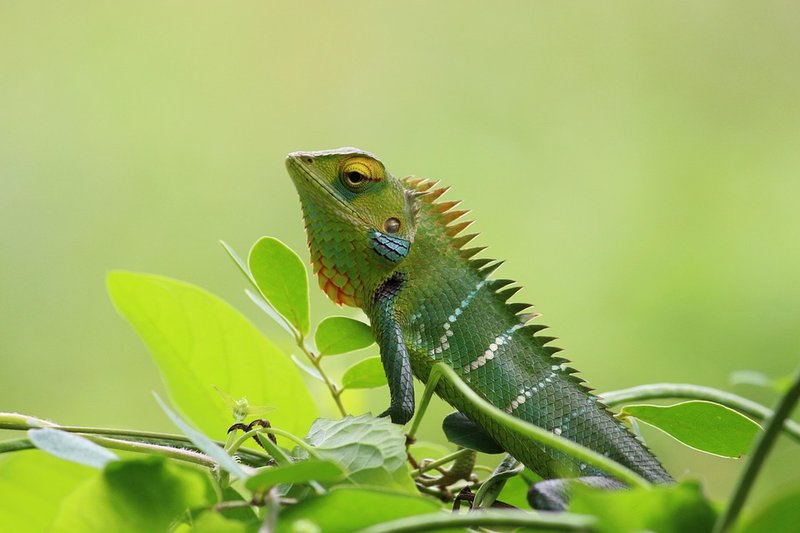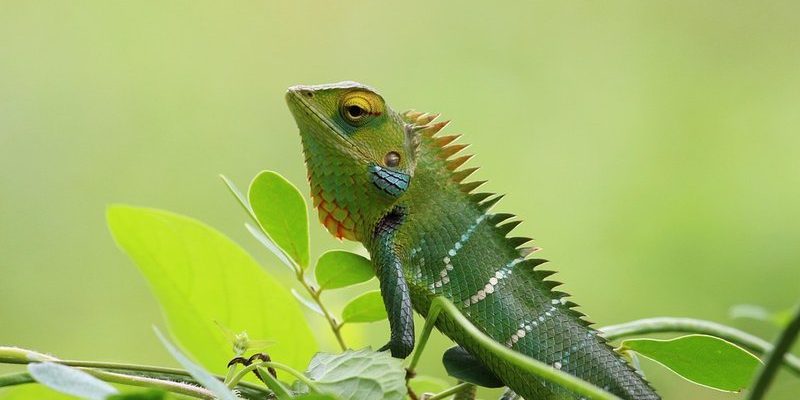
Have you ever seen a color-changing lizard and wondered what makes it so special? That’s the charm of the chameleon! These incredible reptiles are not only captivating to watch but also have fascinating adaptation skills. They belong to the family Chamaeleonidae, with about 200 species scattered across various habitats, from tropical forests to deserts. Each chameleon has its unique characteristics, including the ability to change colors, which isn’t just for show.
Chameleons use their color-changing ability for various reasons. It’s a method of communication, camouflage to avoid predators, and even a way to regulate their body temperature. Imagine being able to blend in seamlessly with your surroundings, or flash brilliant colors to signal to a mate! That’s the magic of chameleons, and it makes them a subject of endless curiosity and admiration.
Physical Characteristics of Chameleons
Chameleons are well-known for their distinctive features. These reptiles come in various shapes and sizes, but they often sport a robust body, a prehensile tail, and zygodactylous feet, which means their toes are grouped in twos, allowing for excellent grip. Their eyes can move independently, giving them a wide range of vision—a clever adaptation to spot both predators and prey.
One fascinating aspect of their appearance is their skin, which contains special cells called chromatophores. These cells can expand or contract to change colors. This ability is influenced by their environment, emotions, and even health status. You might be surprised to learn that some chameleons can display a striking range of shades, from vibrant blues and reds to muted greens and browns, helping them blend into their surroundings or stand out when they want to attract a mate.
Chameleon Habitat and Distribution
Chameleons primarily thrive in warm climates and are most commonly found in Madagascar and Africa. However, they also inhabit parts of Asia and even some European regions. Their favorite spots include lush rainforests, savannahs, and arid deserts. Each species has adapted to its environment, making it crucial for them to be aware of their habitat’s unique characteristics.
Their habitats provide essential resources, including food and shelter. Since they are arboreal creatures (meaning they spend most of their life in trees), chameleons often reside in areas rich in foliage. The dense vegetation offers them hiding spots from predators and the opportunity to hunt for insects, which make up the bulk of their diet.
Diet and Feeding Habits
Speaking of food, chameleons are insectivores. Their diet mainly consists of various insects, such as crickets, grasshoppers, and moths. Some larger species may even consume small birds or other reptiles. What’s interesting is their unique feeding mechanism. Chameleons have long, sticky tongues that can extend up to twice their body length! They use this remarkable tongue to catch prey, often in a fraction of a second.
When hunting, a chameleon will stealthily approach its target, waiting patiently before launching its tongue with incredible speed. This allows them to catch insects that might otherwise escape. Their ability to catch prey efficiently is just one of the many adaptations that help them survive in the wild.
Life Cycle and Reproduction
Like many reptiles, chameleons reproduce through eggs. After mating, females usually lay a clutch of eggs in a safe, underground location. The number of eggs can vary significantly depending on the species, ranging from a few to over a hundred. After about 3 to 12 months, depending on environmental conditions, the eggs hatch, and tiny chameleons emerge, ready to fend for themselves.
The early life of a chameleon is risky, as they face many predators. However, those who survive this stage can live a remarkable lifespan. On average, chameleons live for 5 to 10 years, but larger species can last even longer in captivity, where they are protected from natural threats and provided with a steady food supply.
Color Change: More Than Just a Party Trick
The ability to change color is perhaps the most iconic trait of chameleons. However, it’s not merely for decoration! Color change occurs due to the manipulation of specialized cells in their skin. Chameleons can express a variety of colors based on their mood, temperature, and even the time of day.
For example, a frightened chameleon might turn dark or dull to blend in with its environment, while a male trying to attract a mate may show off bright colors. This fascinating mechanism helps them communicate with others of their kind and can even indicate stress levels. So, next time you see a chameleon changing colors, remember, it’s not just a dramatic display—it’s a complex language!
Chameleons in Popular Culture
Chameleons have captured the imagination of many and are often featured in various forms of media. Whether it’s a whimsical character in animated films or a symbol of adaptability in literature, they hold a unique place in our cultural narrative. Their extraordinary ability to change colors has made them a popular metaphor for transformation and flexibility.
In some regions, chameleons are also considered omens or symbols of luck. The blend of mystery and charm surrounding these reptiles has contributed to their fascination, making them a popular subject for wildlife documentaries, books, and even art. Their role in storytelling highlights how nature can inspire creativity and wonder.
Conservation Status
While chameleons are fascinating creatures, many species face significant threats due to habitat loss, climate change, and the pet trade. As forests are cleared for agriculture or urban development, their homes are disappearing, leading to declining populations. Some species are classified as endangered, making conservation efforts crucial.
Organizations and wildlife enthusiasts are working diligently to protect chameleons and their habitats. Education is vital in raising awareness about the importance of biodiversity and the need to protect these unique reptiles. By supporting conservation initiatives, we can help ensure that future generations will be able to enjoy and learn from chameleons.
How to Care for a Pet Chameleon
If you’re thinking about bringing a chameleon into your home, there are some essential things to consider. Firstly, it’s crucial to understand that chameleons require specific conditions to thrive. A spacious enclosure with plenty of climbing opportunities, appropriate humidity, and temperature gradients is necessary for their well-being.
Chameleons can be sensitive creatures, so it’s essential to provide a balanced diet of insects and, if necessary, vitamins and calcium supplements. Regular monitoring of their health is equally important, as chameleons can be prone to stress and illness. With proper care, your chameleon can live a long and healthy life, bringing joy and wonder into your home.
Interesting Facts About Chameleons
| Species Count: | About 200 species worldwide |
| Habitat: | Tropical forests, savannahs, deserts |
| Diet: | Insects and occasional small vertebrates |
| Life Span: | 5 to 10 years, longer in captivity |
| Color Change: | Used for communication, camouflage, and temperature regulation |
| Unique Feature: | Eyes can move independently |
Chameleons are extraordinary creatures that offer us a glimpse into the wonders of nature. From their stunning color-changing abilities to their unique adaptations for survival, these reptiles truly stand out in the animal kingdom. Whether you’re a nature enthusiast or considering one as a pet, understanding their needs and behaviors can help foster a deeper appreciation for them.
As we learn more about chameleons, let’s also remember the importance of conservation efforts to protect their habitats and unique characteristics. By spreading awareness, we can ensure that these remarkable reptiles continue to thrive for generations to come.
FAQ
Do all chameleons change color?
Not all chameleons change color in the dramatic ways we often see in films or nature documentaries. While many species can adjust their skin color, the degree and speed of change can vary significantly among different types. For some, colors may shift subtly based on mood, temperature, and environmental factors, while others may display more pronounced changes.
What do chameleons eat in the wild?
In the wild, chameleons primarily consume a diet of insects, including crickets, grasshoppers, and moths. Depending on their size, some may also eat small birds and other reptiles. Their hunting strategy involves being patient and stealthy, allowing them to use their impressive tongues to snatch unsuspecting prey with speed and precision.
How do chameleons regulate their body temperature?
Chameleons regulate their body temperature through behavioral adaptations. Since they are ectothermic (cold-blooded), they rely on external heat sources. They often bask in sunlight to warm up and may move to shaded areas to cool down. Additionally, their color can affect temperature regulation, as darker colors absorb more heat compared to lighter shades.
Can chameleons see in color?
Yes, chameleons have excellent color vision, which is believed to be superior to that of humans. Their large, independently moving eyes allow them to spot a wide range of colors and movements. This ability is essential for finding food and communicating effectively with other chameleons using their vibrant colors.
Are chameleons social animals?
Chameleons are generally solitary creatures. They are territorial by nature, especially males, who may display aggressive behaviors toward others of the same sex. However, some species may tolerate the presence of others when necessary, usually during mating seasons. It’s essential to consider their natural behaviors when keeping them in captivity.
How long do chameleons live in captivity?
In captivity, chameleons can live significantly longer than they do in the wild, often reaching 10 years or more, depending on the species and the care they receive. Providing optimal living conditions, proper diet, and health monitoring can contribute to a longer lifespan for these unique reptiles.
What is the best habitat for a pet chameleon?
The ideal habitat for a pet chameleon includes a spacious enclosure with plenty of climbing branches, live plants for humidity, and proper lighting. A temperature gradient should be maintained, with a basking area that has higher temperatures and cooler areas where the chameleon can move to regulate its body heat. Proper humidity levels are also crucial for their health.
Do chameleons make good pets?
Chameleons can make fascinating pets for the right owner. However, they require specialized care and conditions that may not be suitable for all pet owners. Their sensitive nature and unique needs mean that you should be well-informed before adopting one. If you’re prepared to meet their requirements, chameleons can be rewarding companions.
How do you know if a chameleon is healthy?
To ensure your chameleon is healthy, look for bright coloration, clear eyes, and active behavior. Weight should be stable, and the skin should be free of lesions or abnormalities. Regular visits to a reptile-savvy veterinarian will also help monitor their health and address any concerns. Observing these factors closely will help you keep your chameleon happy and thriving.
Can chameleons live with other pets?
While some chameleons can tolerate the presence of other reptiles or even other chameleons, it’s generally advised to keep them alone or with their kind during breeding. Housing them with other pets, such as cats or dogs, can pose significant risks. Most household pets are unaware of a chameleon’s delicate nature and may unintentionally harm them.
How can I help with chameleon conservation?
You can contribute to chameleon conservation by supporting wildlife organizations that focus on habitat preservation and education. Spreading awareness about the challenges they face, such as habitat loss and the illegal pet trade, can encourage others to join the cause. Additionally, choosing not to adopt wild chameleons as pets can help reduce pressure on their populations.

